
6 Essential Texts of Climate Change Written By Women
(But First, Read the National Climate Assessment!)
For many of us, climate change is a broad topic that affects so many environmental systems that it’s difficult to grasp exactly how it works—particularly when you factor in phenomena that contribute to climate change, such as melting sea ice and permafrost, or forest loss in the Amazon. The US Global Change Research Program has done a great job of making their recent National Climate Assessment accessible to all users—you can browse overview data or look at information for a specific region. They even have interactive graphs to show what drives climate change.
But to make the most of this critical next decade and address the global warming crisis, we need to learn as much as we can about climate-related problems and figure out what can and can’t be done to address them. An approach centered on individual experience and knowledge will make these issues more manageable for everyone.
We must also keep in mind who is most affected by climate change. As Kathleen Dean Moore writes in Great Tide Rising, “The burdens of climate change—hunger and thirst, poisoned air and water, inundation, disruption, and wars—are imposed disproportionately on the world’s poorest communities and those that are the least responsible for its effects.” This makes our responsibility to address climate change even more urgent.
I recommend the following six books by women writing about climate change. I’ve chosen women writers because they are often overlooked when it comes to popular science writing. Additionally, they provide a diverse perspective on the climate issues they address. They tackle a range of problems, from sea level rise and species extinctions, to conservation and our ethical duties in the climate change era. These books not only provide scientific background about what’s happening, they also discuss the steps communities and individuals are taking to better manage environmental systems, and to become more resilient to climate change.
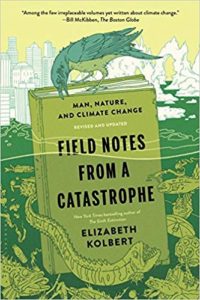
Elizabeth Kolbert, Field Notes from a Catastrophe
(Bloomsbury USA)
Kolbert is a seasoned journalist, and this book was one of the first to collate international studies about climate change. She provides a brief summary of the history of climate change research, then gives an overview of where and how climate change is being observed: melting permafrost, record melt on the Greenland Ice Sheet, changes in sea ice, shifts in ocean currents, the increasing number and intensity of hurricanes, etc. What’s interesting is comparing what was happening in climate policy and climate science in 2004-2005, while Kolbert was researching for this book, to today. The information and urgency around climate change were present even then, with then-Senator John McCain quoted as saying “This is clearly an issue that we will win over time because of the evidence.” Twelve years later, it doesn’t seem as though we’ve made much headway, and there are many people who still don’t believe that evidence.
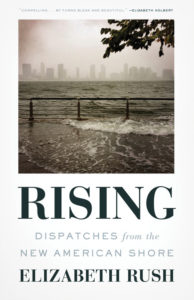
Elizabeth Rush, Rising: Dispatches from the New American Shore
(Milkweed Editions)
Rising focuses on a single aspect of climate change: sea level rise. Rush, an environmental journalist and writer, travels to coastal communities around the United States to see how they are faring with sea level rise and increasingly fierce hurricanes that drive salt water further onshore. This is narrative nonfiction at its best. Rush not only explains the science of sea level rise and the ways in which coastlines can be made more resistant to climate change. She also connects personally with people in flood zones, many of them economically or racially marginalized. She intersperses their first-person stories of flooding and disaster with her own reporting, covering the constant “nuisance flooding” in Florida, caused by increasing sea level and low-lying land; and the relocation of a community hit by Hurricane Sandy, who asked for—and received—government help to move further inland and demolish their old homes so that the shoreline would no longer be populated. She also exposes the problems inherent in regulatory programs like the National Flood Insurance Program (NFIP), that “require [those with insurance] to rebuild in place, even when that place has been underwater repeatedly in the past.”
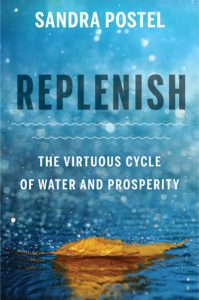
Sandra Postel, Replenish: The Virtuous Cycle of Water and Prosperity
(Island Press)
If you can get past the title of this book (the terms “virtuous” and “prosperity” kind of threw me), it’s an excellent read. Postel, a former Freshwater Fellow of the National Geographic Society and director of the Global Water Policy Project, takes a global look at several aspects of the hydrologic cycle (surface water, groundwater, soil water) and the ways in which water is used (irrigation, human consumption, etc.). She balances much of the negative news about our water resources with stories about people who are doing things differently and have created cross-disciplinary community groups to manage water more sustainably. Each chapter takes on a key issue and then provides an example of what’s being done to address it. In the last chapter of the book, however, Postel notes that the kind of freshwater stewardship she has been describing must yield results, and so far it hasn’t. “At best, it’s one step forward, two steps back. But here and there, we’re making progress.”
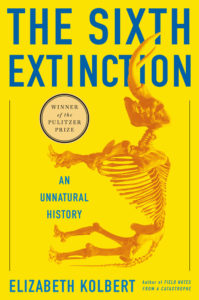
Elizabeth Kolbert, The Sixth Extinction: An Unnatural History
(Henry Holt and Co.)
While Kolbert’s first book was about climate change, her second—which won a Pulitzer Prize—is about extinction. She devotes a lot of space at the beginning of the book explaining how the idea of extinction first came about. This is critical because it contextualizes the sixth extinction, which is happening right now because of human activity. She explains how climate change is causing species to shift up in both elevation and latitude, and that species that aren’t mobile are slowly dying out. Other species are out-of-sync with their ecosystem, finding that, for example, the flowers they rely on for sustenance are flowering earlier, so they arrive too late to get enough food. Ocean species are affected by acidification caused by CO2 absorption. Other species—both plant and animal—are succumbing to diseases and pests that are more prevalent in a warming wold (for example, the mountain pine beetle). Some of the scientists Kolbert interviewed estimated that, if all species were able to move with warming (i.e., “universal dispersal”), “with the minimum warming projected, 9 to 13 percent of all species would be “committed to extinction” by 2050. With maximum warming, the numbers would be 21 to 32 percent.” And this is just an estimate.

Emma Marris, Rambunctious Garden: Saving Nature in a Post-Wild World
(Bloomsbury USA)
In this provocative book, science writer Emma Marris explores conservation—of spaces and species—in the context of climate change. She argues that no place in the world is “pristine” because climate change has affected even the backcountry regions of our favorite national parks. The notion of a “pristine” wilderness is a bit of a red herring, as conservationists more often speak of nature as being wild rather than pristine. Marris discusses an example from British Columbia, where foresters are re-planting clearcuts with seedlings that are expected to survive in the biogeoclimatic ecosystem (BEC) zone those regions will turn into in the future—a process called “assisted migration.”
Marris also suggests we embrace exotic/invasive species that appear in our area because of climate change, and that we support “novel ecosystems” (those altered by human activity but not actively managed), particularly if they are interacting as a complex ecosystem and providing key ecosystem services. She also advocates for accepting green or wild spaces in urban areas as functioning ecosystems. This perspective in particular has taken off in the past five years, with an increasing number of scientists studying urban ecology. Marris writes, “I think we should keep lots of land unmanaged just to see what it does, to keep those evolutionary fires burning, and to ensure that future generations might still be able to get lost.”
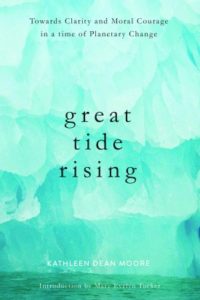
Kathleen Dean Moore, Great Tide Rising: Toward Clarity and Moral Courage in a Time of Planetary Change
(Counterpoint)
It’s one thing to understand the science behind climate change, sea level rise, freshwater challenges, species extinctions, and conservation of biotic systems. It’s another thing to consider our moral responsibility to maintaining these processes, instead of mortgaging our children’s future for our own comfort in the present. Moore, a Distinguished Professor of Philosophy at Oregon State University, taps into her own experiences at both her Alaska cabin and her Oregon home to outline a moral and ethical approach to our responsibilities re: climate change. Moore argues that: “climate change is a violation of human rights . . . a crisis of the imagination . . . [and] a crisis of character.” She outlines “reasons for saving the world,” and notes that she and a group of 23 colleagues drafted The Blue River Declaration, which starts with: “A truly adaptive civilization will align its ethics with the ways of the Earth.” One thing that stands out about this Declaration—and the book itself—is how many people it will really reach. Who even knows about the Declaration? Who is thinking about the moral issues around climate change? While Moore skillfully weaves personal experience with philosophical approaches to sustainable living on planet Earth, I suspect her audience is limited to the privileged few, and will likely not reach the marginalized people most affected by climate change.
Sarah Boon
Sarah Boon is a freelance writer and editor. She has published essays, book reviews, author interviews, and articles in a range of magazines and journals, including Science, Nature, Longreads, Flyway Journal, Electric Literature, and others. She trained as an environmental scientist and held a tenured position in physical geography before returning to her writing and editing roots. She is a member of the Creative Nonfiction Collective Society and the Federation of BC Writers, and a Fellow of the Royal Canadian Geographical Society. She was a co-founder of the Canadian science blogging network Science Borealis. She blogs at https://watershednotes.ca/ and lives and works on southern Vancouver Island, traditional unceded territory of the Quwut’sun people.



















